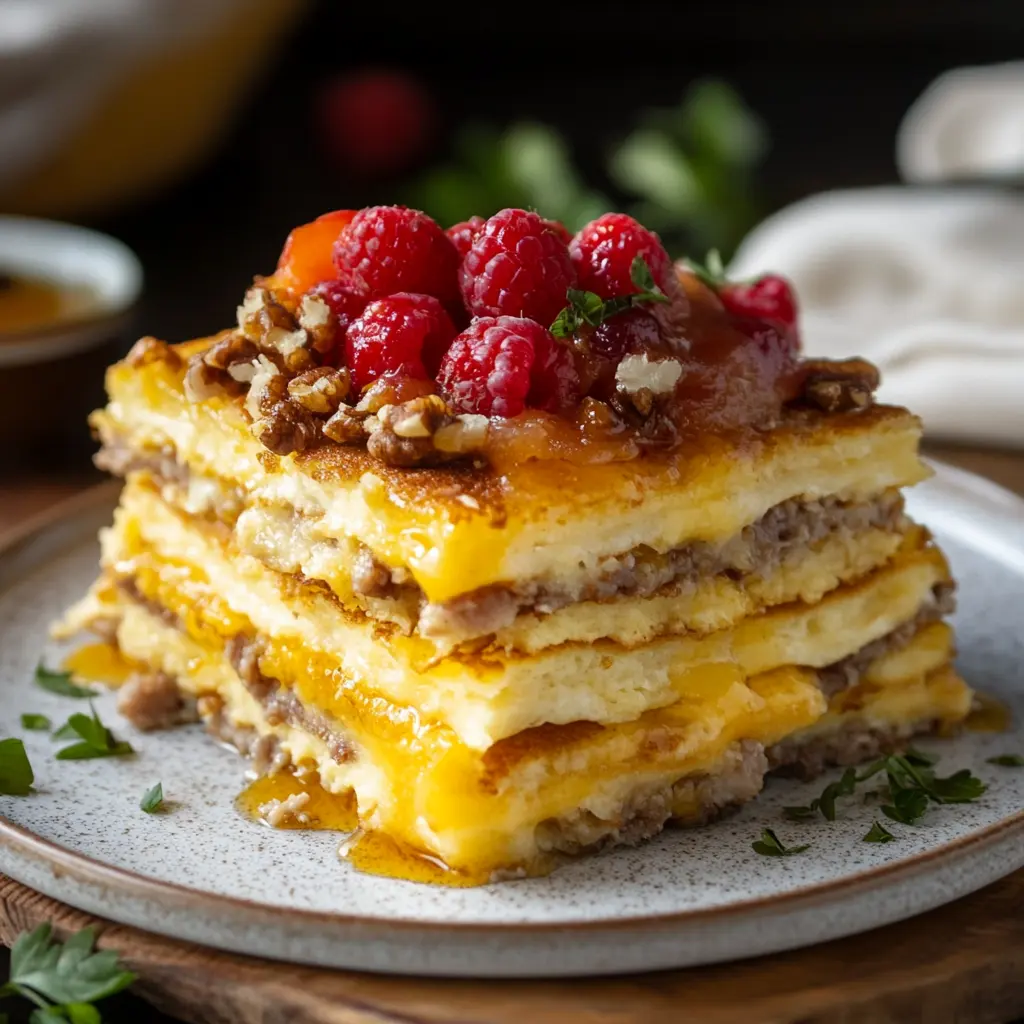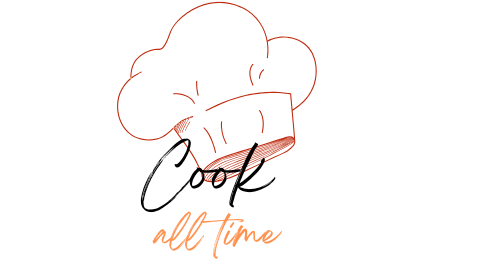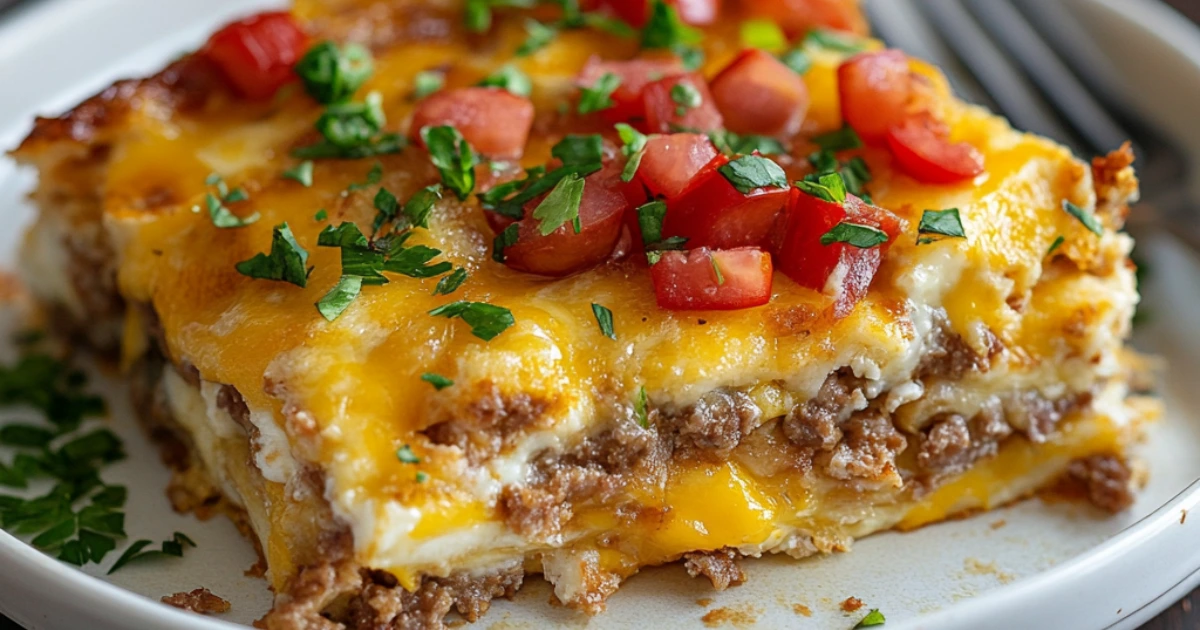Introduction
A pancake breakfast casserole is the perfect solution for a hearty breakfast that can feed a crowd with minimal effort. Combining the comfort of pancakes with the convenience of a casserole, this dish is a popular choice for brunches, holiday mornings, or even as a make-ahead breakfast. The best part? It’s highly customizable to suit different tastes and dietary preferences. Whether you prefer your casserole with sweet toppings, savory fillings, or a mix of both, the pancake casserole offers endless possibilities for variation. In this article, we will explore how to make a delicious pancake breakfast casserole from scratch, including the best techniques, ingredients, and flavor combinations.
Table of Contents
Overview of Pancake Breakfast Casserole, Its Versatility, and Appeal
The pancake breakfast casserole is a dish that effortlessly combines the best of both worlds—fluffy pancakes and the convenience of a casserole. This dish is typically served as a breakfast or brunch option and is ideal for feeding multiple people with minimal prep time. Its versatility is one of its greatest strengths. From classic syrup-soaked pancakes to those filled with fruits, meats, or even chocolate chips, the pancake breakfast casserole can be customized to fit any preference.
Why It’s So Appealing:
- Easy to prepare: A one-dish breakfast means fewer pots and pans to clean.
- Customizable: You can add whatever toppings or ingredients you like.
- Feeds a crowd: Ideal for family gatherings or holiday mornings.
The pancake breakfast casserole is not just convenient; it’s also a fun way to enjoy pancakes in a new, elevated form.
What Is a Pancake Breakfast Casserole? Definition, History, and Variations
A pancake breakfast casserole is a baked dish that takes the elements of traditional pancakes—fluffy batter, syrup, and toppings—and layers them in a casserole dish for a more substantial, crowd-friendly meal. The idea is to mix pancake batter with ingredients like eggs, milk, and baking powder, then bake everything together in the oven until it forms a rich, fluffy casserole.
History:
While pancake casseroles aren’t as old as the classic pancake recipe, they have become a popular modern twist on breakfast staples. This dish evolved from the need for a more efficient way to serve pancakes to large groups, making it especially popular for holiday breakfasts and brunch gatherings.
Variations:
- Traditional pancake casserole: A simple blend of batter, maple syrup, and eggs.
- Fruit-filled pancake casserole: Adding fruits like blueberries, strawberries, or apples.
- Savory pancake casserole: Incorporating meat , cheese, and sausage for a more hearty option.
This dish’s flexibility makes it easy to create new versions based on personal preference or dietary needs.
Ingredients for a Pancake Breakfast Casserole: Common and Optional Ingredients for Creating the Perfect Casserole
When preparing a pancake breakfast casserole, you’ll need a solid base of ingredients, but the beauty of this dish lies in its ability to be adapted with a variety of mix-ins and toppings. Below are the essential and optional ingredients you can incorporate.
Common Ingredients:
- Pancake mix or homemade pancake batter
- Eggs to bind the casserole together
- Milk (or dairy-free alternatives like almond milk)
- Baking powder for extra fluffiness
- Maple syrup for sweetness
Optional Ingredients:
- Fruits like blueberries, bananas, or apples
- Savory items like cheese, sausage
- Nuts like pecans or walnuts for texture
- Chocolate chips or cinnamon sugar for indulgent toppings
With these basic ingredients and a few creative additions, your pancake breakfast casserole can become anything you want it to be.
Preparing the Pancakes: Tips for Making the Best Pancakes for the Casserole
A key element of a successful pancake breakfast casserole is making sure your pancakes are fluffy and flavorful before you layer them in the casserole dish. While you can use store-bought pancake mix, making pancakes from scratch ensures the best texture.
Tips for Perfect Pancakes:
- Don’t Overmix: When mixing the batter, it’s important to leave some lumps. Overmixing will result in tough pancakes.
- Rest the Batter: Allowing the batter to sit for about 10 minutes before cooking will help the pancakes rise better.
- Use the Right Pan: A non-stick skillet or griddle works best to avoid pancakes sticking.
- Cook on Medium Heat: Too high, and they’ll burn; too low, and they’ll be flat. Medium heat ensures a golden-brown finish.
For the casserole, cook the pancakes until they are just set but not overly crisp. Once cooked, cut them into cubes to layer in the casserole dish.
Layering the Pancake Breakfast Casserole: How to Create Balanced Flavors and Textures
The key to making a pancake breakfast casserole that is both delicious and visually appealing is mastering the layering technique. Layering ensures that all ingredients are evenly distributed, so you get a perfect balance of flavors in each bite.
Layering Tips:
- Start with Pancakes: Begin with a base layer of pancake cubes to form the foundation of the casserole.
- Add Flavor Layers: Include layers of fruit, chocolate chips, or savory elements like cheese or meats. This creates pockets of flavor throughout the dish.
- Egg Mixture: Pour the egg and milk mixture evenly over the pancakes and toppings to bind the casserole.
- Top It Off: Finish with another layer of pancakes, followed by any remaining toppings (like pecans or maple syrup).
Proper layering ensures that the casserole cooks evenly and results in a cohesive dish where each bite has the right mix of textures and flavors.
Sweet and Savory Combinations in Your Pancake Breakfast Casserole: How to Mix Flavors
While the pancake breakfast casserole is often sweet, incorporating savory elements can add a rich depth of flavor and make it even more satisfying.
Savory Additions:
- Meat or Sausage: Add cooked meat or sausage between the pancake layers for a salty contrast to the sweetness.
- Cheese: Use cheddar, cream cheese, or even goat cheese to create a creamy, rich flavor profile.
- Spinach or Mushrooms: These vegetables add a savory, earthy quality that balances the sweetness of the pancakes.
Mixing savory ingredients like cheese, meat, and herbs with the traditionally sweet components of a pancake breakfast casserole creates a mouthwatering dish that satisfies all tastes.
How to Make a Pancake Breakfast Casserole: Step-by-Step Instructions for Creating the Dish
Now that you’ve learned about the essential components, let’s dive into the step-by-step process for making your own pancake breakfast casserole.
Ingredients:
- 8 pancakes (prepared ahead of time)
- 4 large eggs
- 2 cups milk
- 1/4 cup maple syrup
- 1/2 teaspoon vanilla extract
- 1 cup mixed fruit (blueberries, strawberries, etc.)
- 1 cup shredded cheese (optional)
- 1/2 cup meat bits (optional)
- Butter for greasing the casserole dish
Instructions:
- Preheat Oven: Preheat your oven to 350°F (175°C) and grease a 9×13-inch casserole dish with butter.
- Prepare Pancakes: Cook and cool your pancakes, then cut them into cubes.
- Layer the Pancakes: Place half of the pancake cubes in the bottom of the casserole dish.
- Add Mix-ins: Layer your fruit, meat , and cheese on top of the pancake cubes.
- Make the Egg Mixture: Whisk together the eggs, milk, maple syrup, and vanilla extract until well combined.
- Assemble the Casserole: Pour the egg mixture evenly over the pancakes and toppings. Add the remaining pancake cubes and press them down gently.
- Bake: Bake in the preheated oven for 30-35 minutes, or until the casserole is set and golden brown on top.
- Serve: Allow to cool for 5 minutes before slicing and serving.
By following these steps, you’ll have a perfectly baked pancake breakfast casserole that is both filling and delicious.
For more baking inspiration, read Does Gluten-Free Cookie Dough Freeze Well? to discover how to handle specialty ingredients in baked goods.
Popular Variations of Pancake Breakfast Casserole: Gluten-Free and Vegan Options
One of the great things about a pancake breakfast casserole is its versatility. Whether you’re accommodating dietary preferences or looking to experiment with new flavors, there are many ways to customize this dish. From gluten-free to vegan options, you can make a pancake casserole that fits any dietary need.
Gluten-Free Pancake Casserole:
- Use gluten-free pancake mix or make your own using rice flour or almond flour.
- Ensure that all toppings, such as sausage or cheese, are certified gluten-free.
Vegan Pancake Casserole:
- Substitute plant-based milk (like almond milk) for dairy.
- Replace eggs with a flax egg or chia egg to bind the casserole together.
- Use vegan cheese or nut-based cheese for a dairy-free version.
These variations make the pancake breakfast casserole accessible to nearly everyone, while still maintaining its delicious flavor and texture.
Cooking Methods and Tips: Oven-Baking Techniques, Temperature Guidelines, and Common Mistakes to Avoid
Getting your pancake breakfast casserole perfectly cooked is crucial to its success. Proper baking techniques can ensure the casserole is golden brown on top, while staying soft and fluffy inside. Here are some tips and guidelines to help you bake it to perfection.

Oven-Baking Techniques:
- Preheat your oven: Always preheat the oven to 350°F (175°C) before placing your casserole inside.
- Bake uncovered: This allows the top to become crispy and golden.
- Check doneness: The casserole should be set and no longer jiggly in the center. You can test with a knife—if it comes out clean, it’s done.
Common Mistakes to Avoid:
- Overcrowding the casserole: Ensure even layering of ingredients to avoid uneven cooking.
- Undercooking: Make sure your casserole is fully cooked by checking the center.
- Using cold ingredients: Let refrigerated ingredients come to room temperature to ensure even baking.
By following these tips, you can achieve a perfectly baked pancake breakfast casserole that is fluffy and delicious every time.
Serving Suggestions: How to Serve the Casserole with Toppings, Sides, and Beverages
Once your pancake breakfast casserole is out of the oven, it’s time to serve it. This dish can be enjoyed in a variety of ways with different toppings, sides, and beverages. Here are some creative serving ideas to enhance your meal.
Toppings:
- Fresh berries: Add blueberries, strawberries, or raspberries for a sweet, fruity flavor.
- Whipped cream: A dollop of whipped cream adds extra indulgence.
- Maple syrup: Drizzle maple syrup on top for that classic pancake taste.
- Nuts: Add pecans or walnuts for a bit of crunch.
Side Dishes:
- Breakfast meats: Serve with meat , sausage, or meat for a savory contrast.
- Fresh fruit salad: A refreshing fruit salad balances out the richness of the casserole.
- Potatoes: Roasted potatoes or hashbrowns complement the casserole perfectly.
Beverages:
- Pair with coffee, orange juice, or a smoothie to round out your breakfast or brunch.
These options allow you to personalize your pancake casserole to fit any occasion or taste preference.
Can You Make It Ahead of Time? Preparing, Storing, and Reheating Pancake Breakfast Casserole
The pancake breakfast casserole is perfect for meal prepping or making ahead of time. With proper storage and reheating techniques, you can enjoy this dish without needing to cook from scratch each morning.
Preparing Ahead of Time:
- Assemble the casserole: Prepare the casserole the night before by layering the pancakes and other ingredients, then refrigerating it overnight. This will allow the flavors to meld and make the casserole easier to bake in the morning.
Storing:
- Refrigerate leftovers: Store any leftover casserole in an airtight container in the fridge for up to 3 days.
- Freeze for later: To freeze, allow the casserole to cool completely, then wrap it tightly in plastic wrap and aluminum foil. It can be frozen for up to 3 months.
Reheating:
- Oven: To reheat, bake at 350°F (175°C) for 10-15 minutes until warmed through.
- Microwave: For quick reheating, use the microwave on medium power for 1-2 minutes, stirring halfway through.
With these methods, you can prepare your pancake breakfast casserole in advance, saving time on busy mornings.
Nutritional Benefits: Health Considerations and How to Make a Lighter Version
While a pancake breakfast casserole is a delicious and indulgent dish, you can make it healthier by adjusting the ingredients and portion sizes. Whether you’re looking to reduce calories, cut down on sugar, or increase the nutritional content, there are several ways to make a lighter version.
Healthier Modifications:
- Use whole wheat flour: Swap out white flour for whole wheat or almond flour to increase fiber content.
- Reduce sugar: Use less maple syrup or opt for a sugar substitute like stevia or monk fruit.
- Dairy-free options: Use almond milk or oat milk and vegan butter to lower fat content.
- Add more fruits and vegetables: Incorporate spinach, zucchini, or apples for extra nutrients and fiber.
By making these small changes, you can enjoy a pancake breakfast casserole that fits better with your health goals, without sacrificing flavor.
Pancake Breakfast Casserole for Special Occasions: Ideas for Using the Dish in Brunches, Holidays, or Gatherings

A pancake breakfast casserole is perfect for special occasions, as it can be made in large batches and customized to suit the theme of the event. Here are some ways to incorporate this dish into your next celebration.
Brunches:
- Set up a pancake casserole bar, where guests can choose from different toppings like berries, whipped cream, and syrup.
- Serve it alongside other brunch favorites like quiche, fruit salad, and mimosas.
Holidays:
- For Christmas or Easter, a pancake breakfast casserole can be the star of the breakfast table. Add cinnamon, nutmeg, or ginger to make it festive.
- For Thanksgiving, consider adding pumpkin puree or cranberries to the casserole for a seasonal twist.
Gatherings:
- A pancake breakfast casserole is great for family gatherings or potlucks. Its large serving size and customizable flavors make it ideal for feeding a crowd.
Whether for a casual brunch or a formal holiday breakfast, the pancake breakfast casserole is an easy way to impress guests and make the event memorable.
FAQs: Frequently Asked Questions About Preparation, Storage, and Serving
Here are answers to some of the most frequently asked questions about making and serving a pancake breakfast casserole.
1. Can I make a pancake breakfast casserole the night before?
Yes, you can prepare it the night before and refrigerate it overnight. Bake it the next morning for an easy, stress-free breakfast.
2. Can I freeze the pancake breakfast casserole?
Absolutely! You can freeze the casserole for up to 3 months. Just bake it first, then let it cool before freezing. Reheat it in the oven for the best results.
3. How do I keep the casserole from becoming soggy?
Ensure that your pancake batter is not too runny, and avoid over-soaking the casserole with too much liquid. Use enough egg to bind everything together without making it soggy.
4. What toppings are best for a pancake breakfast casserole?
Some great options include fresh fruit, maple syrup, whipped cream, and nuts. You can also add savory toppings like meat or cheese for a different flavor profile.
By addressing these questions, you can approach making your pancake breakfast casserole with confidence.
Conclusion
The pancake breakfast casserole is an incredibly versatile dish that can be customized to suit any occasion or dietary need. From gluten-free and vegan options to decadent savory or sweet variations, there is a pancake breakfast casserole for everyone. Whether you’re preparing it ahead of time, serving it at a special event, or simply enjoying it with family, this dish is sure to become a breakfast favorite. With the tips and techniques shared in this article, you can make a pancake breakfast casserole that is both delicious and memorable.


2 thoughts on “Pancake Breakfast Casserole: Easy, Delicious, and Customizable Recipe”